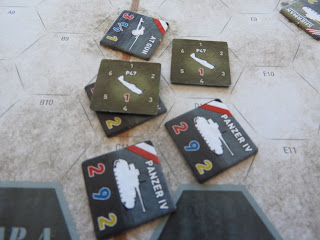The holidays are nearly over and I've had a lot of fun playing more wargames in the last four weeks than I have in the last twelve months. This is mainly due to my switch over to playing some simple, low brain cell board and counter games, with an emphasis on print and play to keep the cost down to a minimum.
I decided to start this blog to chart my adventures in 'beer and pretzels' lead free gaming, and it has been a really positive experience, in contrast to my frustrated attempts to get some miniature based stuff done this year. The work side of my life has been terrible over the last couple of years, so the Tea and a Wad blog has given me a real boost.
Anyway, to cheer myself up before I get back to the slog through at work next week, I decided to splash out on a copy of Tank on Tank: Eastfront, which wasn't cheap but will be a splendid addition to my wargame collection. I've enjoyed playing the Westfront version of this game so, with loads more units, new geomorphic maps, special rules and extra scenarios, the Russian Front original should be great.
Unfortunately, this does mean I've blown a major hole in my wargaming budget for next month, which will probably lead to some of my miniature gaming plans being put on hold. It's Colours 2016 next weekend too, so I'll have to save up my pocket money for the show, especially as I have some resurgent naval wargaming projects in the pipeline for the autumn which could do with a few extras.
Whatever happens and no matter how swamped I am with work, I'll still find the time for more 'beer and pretzels', one brain cell wargaming!

































































